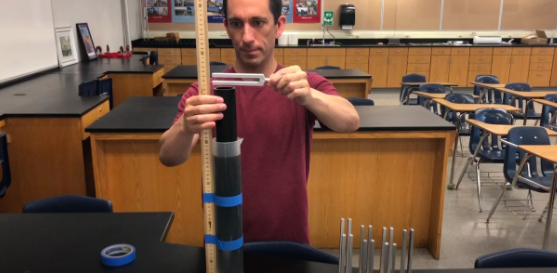While sitting at his desk on a recent Sunday evening, junior Anthony Zheng rubbed his eyes, straining to determine which hash mark the end of a metal rod landed on in the lab video, something that would have easily been done in-person. In the video, physics teacher Matthew Welander’s voice echoed as he described the effects that a hanging mass had on the system’s moment of inertia.
Such difficulties with online learning are common in science classes, which have been challenged to convert hands-on curricula such as labs into a virtual format.
Welander has faced many of the struggles common among STEM teachers: an inability to set up labs and check in on students doing them. Previous labs and projects have instead been turned into simulations or cut out of the curriculum entirely.
One such example is the rotational dynamics lab, in which students were supposed to use two different equations to estimate the rotational inertia of a spinning rod with masses attached.
Instead of doing the lab with equipment and recording their own data, students watched a video of Welander doing the experiment and then copied the information shown.
“It's a lot harder to demonstrate how to connect components together when students have to view my demonstrations through a webcam or document camera, as opposed to being able to pick up the object in their hands and inspect it up close,” Welander said.
Students also find it frustrating that online learning has prevented them from gaining hands-on experience with certain concepts.
“I do not like doing the labs online,” Zheng said. “You're watching someone else do it, and it's basically like notes.”
In addition to losing guidance on labs, students and teachers alike have struggled with communication online. Without in-person support, students may fall behind without being able to ask questions as a result of the schedule’s shorter periods: 75 minutes compared to the previous 90 and meeting one time fewer every two weeks.
Because students either don’t have time to ask questions or are less comfortable doing so online, they often have to send emails or wait until office hours. With hours or even days before a student receives the help they need, they may struggle to complete the homework or have a gap in their understanding of a concept.
Despite these enormous challenges, Welander has found ways to give his students as much support as possible. These methods include online workbooks, videos and even Canvas discussions where students can share resources they have found.
"Physics online hasn't been as bad as I expected, mainly because of tools like AP Classroom and the MIT Workbook, both of which Mr. Welander provides,” junior Soorya Kuppam said. “The class itself is very difficult, and online school alleviates a bit of the stress. I think that with online school, we're given a lot of time to process what we know.”
AP Classroom is available on the College Board website and has chapter reviews and AP questions for students to practice. The MIT workbook has many conceptual problems that help develop a student’s understanding of the topic.
Currently, Welander’s biggest concern is the upcoming robotics/programming unit in his Principles of Engineering course. Usually, students work in pairs to build and program their own robot, as only 16 sets of material are available, but virtual learning means he’ll have to take a different approach.
Welander said he could split the students into two groups, with one working on simulator activities and the other building robots. After a few weeks, they would switch.
“I really don't know how the logistics would work out, or if it's even a good idea to have students working on completely different projects at the same time, both of which would probably require a lot of help from me,” Welander said.
Welander has also contemplated having the students work in pairs, with each student doing one half of the work. One student would do the programming section, and one would do the building, and after they have finished, the students would switch roles and finish the project.
Despite the challenges posed by the shift to online learning, Welander’s students said he has come up with creative and effective ways to help their students understand their material.
“I still feel like Welander is doing a great job given the circumstances,” Zheng said. “If we go back to in-person school next semester, I feel like he will do an even better job.”


























